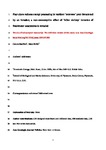Fear alone reduces energy processing by resident ‘keystone’ prey threatened by an invader; a non-consumptive effect of ‘killer shrimp’ invasion of freshwater ecosystems is revealed
| dc.contributor.author | MacNeil, C | |
| dc.contributor.author | Briffa, Mark | |
| dc.date.accessioned | 2019-06-24T10:29:08Z | |
| dc.date.available | 2019-06-24T10:29:08Z | |
| dc.date.issued | 2019-07 | |
| dc.identifier.issn | 1146-609X | |
| dc.identifier.issn | 1873-6238 | |
| dc.identifier.uri | http://hdl.handle.net/10026.1/14370 | |
| dc.description.abstract |
Non-consumptive effects (NCEs)of predators – so called ‘fear’ responses – encompass costly antipredator behaviours, such as reduced feeding efficiency. NCEs can influence prey population dynamics and community structure, if prey are ‘keystone’ species such as Gammarus spp. amphipod ‘shrimps’. These freshwater macroinvertebrates have the ecosystem functional role of shredding fallen leaf litter, making it accessible to other taxa. Across Europe, the invasive predatory ‘killer shrimp’ Dikerogammarus villosus is replacing resident Gammarus spp., potentially threatening this vital ecosystem function. While predation (consumptive effects (CEs))of this invader has been well studied, for the first time we test whether NCEs can be evident in prey only exposed to D. villosus presence and whether this could potentially impact on the prey's functional role. In mesocosms, exposure to constrained D. villosus did not result in mortalities of any of three Gammarus prey species but the leaf shredding efficiencies of all prey were significantly reduced compared to a control treatment. This clear NCE has the potential to propagate through the ecological community via decreased energy processing. This study demonstrates the potential for fear of invasive predator presence alone to impact on ecosystem function. | |
| dc.format.extent | 1-5 | |
| dc.language | en | |
| dc.language.iso | en | |
| dc.publisher | Elsevier | |
| dc.subject | Consumptive effect (CE) | |
| dc.subject | Dikerogammarus | |
| dc.subject | Killer shrimp | |
| dc.subject | Non-consumptive effect (NCE) | |
| dc.subject | Shredders | |
| dc.title | Fear alone reduces energy processing by resident ‘keystone’ prey threatened by an invader; a non-consumptive effect of ‘killer shrimp’ invasion of freshwater ecosystems is revealed | |
| dc.type | journal-article | |
| dc.type | Journal Article | |
| plymouth.author-url | https://www.webofscience.com/api/gateway?GWVersion=2&SrcApp=PARTNER_APP&SrcAuth=LinksAMR&KeyUT=WOS:000474318800001&DestLinkType=FullRecord&DestApp=ALL_WOS&UsrCustomerID=11bb513d99f797142bcfeffcc58ea008 | |
| plymouth.volume | 98 | |
| plymouth.publication-status | Published | |
| plymouth.journal | Acta Oecologica | |
| dc.identifier.doi | 10.1016/j.actao.2019.05.001 | |
| plymouth.organisational-group | /Plymouth | |
| plymouth.organisational-group | /Plymouth/Faculty of Health | |
| plymouth.organisational-group | /Plymouth/Faculty of Health/School of Psychology | |
| plymouth.organisational-group | /Plymouth/Faculty of Science and Engineering | |
| plymouth.organisational-group | /Plymouth/REF 2021 Researchers by UoA | |
| plymouth.organisational-group | /Plymouth/REF 2021 Researchers by UoA/UoA04 Psychology, Psychiatry and Neuroscience | |
| plymouth.organisational-group | /Plymouth/Research Groups | |
| plymouth.organisational-group | /Plymouth/Research Groups/Marine Institute | |
| plymouth.organisational-group | /Plymouth/Users by role | |
| plymouth.organisational-group | /Plymouth/Users by role/Academics | |
| plymouth.organisational-group | /Plymouth/Users by role/Researchers in ResearchFish submission | |
| dcterms.dateAccepted | 2019-05-01 | |
| dc.rights.embargodate | 2020-5-9 | |
| dc.identifier.eissn | 1873-6238 | |
| dc.rights.embargoperiod | Not known | |
| rioxxterms.versionofrecord | 10.1016/j.actao.2019.05.001 | |
| rioxxterms.licenseref.uri | http://www.rioxx.net/licenses/all-rights-reserved | |
| rioxxterms.licenseref.startdate | 2019-07 | |
| rioxxterms.type | Journal Article/Review |


